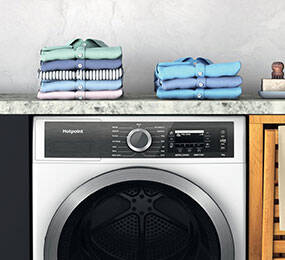Condenser vs Heat Pump Tumble Dryers
Did you know there are two different types of tumble dryers to choose from when shopping for this essential laundry appliance at Hotpoint?
You can select either a condenser tumble dryer or a heat pump tumble dryer, each offering unique benefits, different purchase prices, and varying running costs.
Let us explain the difference between these two types of tumble dryers in more detail…
What is a condenser tumble dryer?
A condenser tumble dryer uses a heating element to dry your clothes, with the moisture extracted from your garments collected in an easy-to-empty container.
This means there is no need for a vent hose, so it can be installed wherever is convenient within a well-ventilated room in your home. Just remember that the appliance’s water tank must be emptied after every cycle.
A condenser dryer is generally more affordable and cheaper to run than a heat pump tumble dryer, and stands out in the market for these reasons:
- A condenser tumble dryer converts hot air into water, which can then be easily removed by the appliance’s owner.
- Condenser tumble dryers can reach temperatures above 70°C, which may shorten drying times. But higher heat uses more energy, and in practice, most cycles run cooler depending on the programme chosen.
- A built-in condenser system helps reduce the risk of dampness in the room where the appliance is installed.
What is a heat pump tumble dryer?
A heat pump tumble dryer is the most modern, energy-efficient and financially sustainable type of dryer, but is also generally the most expensive at the point of purchase.
Unlike the condenser models, heat pump dryers don’t use a heating element to dry laundry. Instead, they use recirculated air to dry your clothes at much lower temperatures inside the drum.
The low temperatures make heat pump tumble dryers more energy-efficient to run, while also being gentler on your clothes - helping to prevent fabric damage, fading, and shrinking.
Similar to why eco cycles on washing machines take longer, heat pump drying cycles will take longer than condenser dryers because they dry at lower temperatures.
Heat pump dryers collect extracted moisture in a tank, so they can be installed wherever it’s most convenient in your home - though they work best in typical household temperatures, so garages or outdoor buildings are usually not ideal. However, with Hotpoint’s ColdGuard technology, your dryer is designed to work efficiently in temperatures as low as 0°C, allowing you to place it in garages or outbuildings when kitchen space is limited.
They also catch the eye in the laundry appliance market for these reasons:
- A heat pump tumble dryer will reuse the hot air that it generates.
- They are usually quieter when in use compared to other types of tumble dryers.
How much could I save?
Heat pump tumble dryersare usually more expensive to purchase than condenser models. However, the amount of money you will save on your energy bills, as well as the savings you’ll make from your clothes lasting longer, Will typically outweigh the higher upfront cost.On average, using a heat pump dryer costs around 63p per cycle, while a condenser model is closer to £1.78. Actual costs will vary depending on the appliance’s size, energy rating, and chosen programme.
You can find out how much you’d save with a heat pump dryer by using the Youreko calculator available on our website, which is visible on each of the product pages.
How to clean your tumble dryer’s filter
To make sure your tumble dryer performs at maximum efficiency, you should clean the filter after every cycle. Here’s how:
- The filter can be located at the bottom of the porthole when you open the tumble dryer’s door.
- Remove the filter by lifting it up.
- You can scrape away all the fluff and then run the filter under a tap to completely clean it.
- Wait for it to dry before placing it back inside the tumble dryer.
If you want to know more about taking care of your tumble dryer, check out our step-by-step guide for cleaning your dryer.
Made up your mind about which type of laundry appliance will be best for your home? Shop our full selection of tumble dryers here and buy the model that perfectly suits your household’s needs online today.
Don’t forget to register for our newsletter if this is the first time you have ordered directly from the Hotpoint website, so that we can gift you with free delivery on your purchase.
Top tips for saving energy when using a tumble dryer
Making sure you use your tumble dryer correctly can help you to reduce running costs even further, no matter which model you choose.
If you’re using a heat pump dryer, try to avoid opening the door mid-cycle to check if your clothes are dry. As heat pumps take longer to reach maximum temperatures, you’ll interrupt this procedure by opening the door. The dryer will then have to work harder to get back to the right temperature, meaning extra time will be added to the cycle.
Always make sure you empty the water tank after each cycle too.
You can lower the energy your tumble dryer uses with each cycle by following these simple tips:
- Put a spin cycle on when your clothes are in the washing machine, so that extra moisture can be removed from clothes before they are moved into the tumble dryer.
- Clothes should be untangled before placing them into your tumble dryer. If you don’t separate the clothes, more energy will likely need to be used to get the clothes evenly dried.
- Sort your tumble dryer loads by similar fabrics to ensure each they dry evenly and efficiently. For example, lightweight items like blouses dry faster than bulky towels, so keeping them separate saves time and energy.
- Only switch your tumble dryer on once it has a full load, as the same amount of energy will be used regardless of how many clothes are in the drum.
- Avoid overloading a tumble dryer though, as the appliance will need to use more energy and take more time to get all the clothes dry.
- Avoid adding very wet items into your tumble dryer partway through a cycle, even just a few pieces. The extra moisture can dampen what’s already dry, forcing the dryer to work harder and use more energy to finish the job.
- Dry multiple loads back-to-back whenever you can, the second load and beyond will dry faster thanks to the drum already being warm, saving you time and energy.
1Saving calculated by Youreko and are based on the energy usage of models H1 D80W UK, H3 D81WB UK, and NT M11 8X3XB UK compared to the least efficient 8kg model in the market, operating on the standard cotton cupboard dry programme as published on product fiche or energy label, completing 254 cycles per year (5 per week) over 13 years, with an average current energy cost of 34p per kWh and an average annual increase in electricity costs of 4.92% per year. Further details on calculations can be found at Hotpoint.co.uk. Savings calculated 25/11/2022 and may vary depending on other factors such as usage, energy cost fluctuations, cycle type etc.
2Up to 40% based on jeans programmes without ActiveCare.
















.png)


